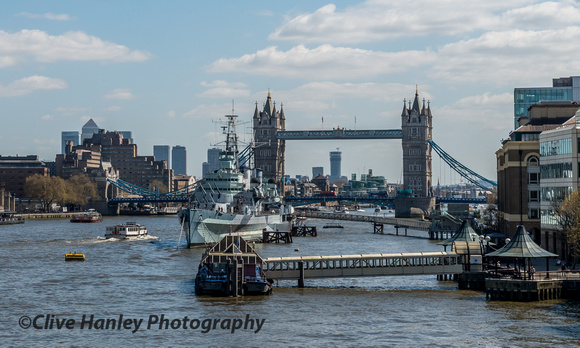Belfast is a cruiser of the
second Town class. The Town class had originated in 1933 as the
Admiralty's response to the
Imperial Japanese Navy's
Mogami-class cruiser, an 11,200-ton cruiser mounting fifteen 6-inch guns with a top speed exceeding 35 knots. The Admiralty's
requirement called for a 9,000 ton cruiser, sufficiently armoured to withstand a direct hit from an 8-inch shell, capable of 32 knots and mounting twelve 6-inch guns. Seaplanes carried aboard would enable shipping lanes to be patrolled over a wide area, and the class was also to be capable of its own anti-aircraft defence. Under the
Director of Naval Construction the new design evolved during 1933. The lead ship of the new class, the 9,100-ton
HMS Southampton, and her sister
HMS Newcastle, were ordered under the 1933 estimates. Three more cruisers were built to this design, with a further three ships built to a slightly larger 9,400-ton design in 1935ndash;36.
[11] By 1935, however, the Admiralty was keen to improve the firepower of these cruisers to match the firepower of the Japanese
Mogami- and American
Brooklyn-class cruisers; both were armed with fifteen 6-inch guns. The Admiralty rejected a design featuring five triple turrets as impractical, while an alternative design fitting four quadruple turrets was rejected as an effective quadruple turret could not be developed.
[12] In May 1936 the Admiralty decided to fit triple turrets, whose improved design would permit an increase in deck armour. This modified design became the 10,000-ton Edinburgh subclass, named after
Belfast's sister ship
HMS Edinburgh.
Belfast was ordered from
Harland and Wolff on 21 September 1936, and her keel laid on 10 December 1936. Her expected cost was pound;2,141,514; of which the guns cost pound;75,000 and the aircraft (two
Supermarine Walruses) pound;66,500. She was launched on
Saint Patrick's Day, 17 March 1938, by
Anne Chamberlain, the wife of Prime Minister
Neville Chamberlain.The launch was filmed by Pathe News.From March to August 1939
Belfast was fitted out and underwent sea trials.


